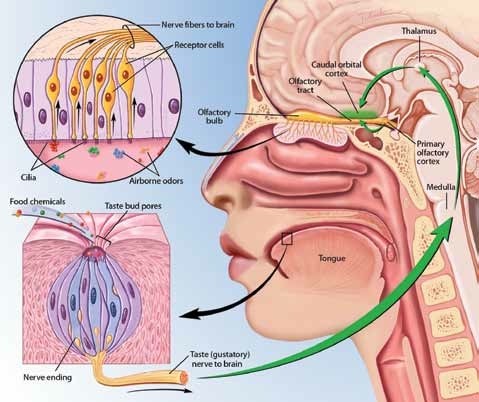CHAPTER 3: Senses and Perception
In this Chapter
Taste and Smell
1Although most of us don’t think of it in this way, the related senses of taste and smell help us interpret the chemical world. Just as sound is the perception of changes in air pressure and sight the perception of light, tastes and smells are the perception of chemicals in the air or in our food. Separate senses with their own receptor organs, taste and smell are nonetheless intimately entwined.
2This close relationship is most apparent in how we perceive the flavors of food. As anyone with a head cold can attest, food “tastes” different when the sense of smell is impaired. Actually, what is really being affected is the flavor of the food, or the combination of taste and smell. That’s because only the taste, not the food odors, are being detected. Taste itself is focused on distinguishing chemicals that have a sweet, salty, sour, bitter, or umami taste (umami is Japanese for “savory”). However, interactions between the senses of taste and smell enhance our perceptions of the foods we eat.

3Tastants, chemicals in foods, are detected by taste buds, special structures embedded within small protuberances on the tongue called papillae. Other taste buds are found in the back of the mouth and on the palate. Every person has between 5,000 and 10,000 taste buds. Each taste bud consists of 50 to 100 specialized sensory cells, which are stimulated by tastants such as sugars, salts, or acids. When the sensory cells are stimulated, they cause signals to be transferred to the ends of nerve fibers, which send impulses along cranial nerves to taste regions in the brainstem. From here, the impulses are relayed to the thalamus and on to a specific area of the cerebral cortex, which makes us conscious of the perception of taste.
4Airborne odor molecules, called odorants, are detected by specialized sensory neurons located in a small patch of mucus membrane lining the roof of the nose. Axons of these sensory cells pass through perforations in the overlying bone and enter two elongated olfactory bulbs lying against the underside of the frontal lobe of the brain.
5Odorants stimulate receptor proteins found on hairlike cilia at the tips of the sensory cells, a process that initiates a neural response. An odorant acts on more than one receptor, but does so to varying degrees. Similarly, a single receptor interacts with more than one different odorant, though also to varying degrees. Therefore, each odorant has its own pattern of activity, which is set up in the sensory neurons. This pattern of activity is then sent to the olfactory bulb, where other neurons are activated to form a spatial map of the odor. Neural activity created by this stimulation passes to the primary olfactory cortex at the back of the underside, or orbital, part of the frontal lobe. Olfactory information then passes to adjacent parts of the orbital cortex, where the combination of odor and taste information helps create the perception of flavor.

